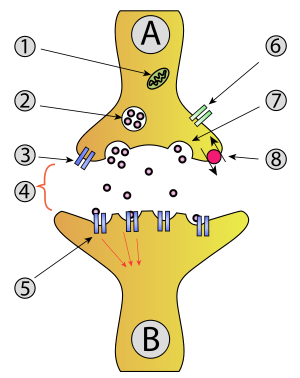
- Mitochondrion
- Synaptic vesicle with neurotransmitters
- Autoreceptor
- Synapse with neurotransmitter released (serotonin)
- Postsynaptic receptors activated by neurotransmitter (induction of a postsynaptic potential)
- Calcium channel
- Exocytosis of a vesicle
- Recaptured neurotransmitter
Exocytosis (/ˌɛksoʊsaɪˈtoʊsɪs/[1][2]) is a form of active transport and bulk transport in which a cell transports molecules (e.g., neurotransmitters and proteins) out of the cell (exo- + cytosis). As an active transport mechanism, exocytosis requires the use of energy to transport material. Exocytosis and its counterpart, endocytosis, are used by all cells because most chemical substances important to them are large polar molecules that cannot pass through the hydrophobic portion of the cell membrane by passive means. Exocytosis is the process by which a large amount of molecules are released; thus it is a form of bulk transport. Exocytosis occurs via secretory portals at the cell plasma membrane called porosomes. Porosomes are permanent cup-shaped lipoprotein structures at the cell plasma membrane, where secretory vesicles transiently dock and fuse to release intra-vesicular contents from the cell.
In exocytosis, membrane-bound secretory vesicles are carried to the cell membrane, where they dock and fuse at porosomes and their contents (i.e., water-soluble molecules) are secreted into the extracellular environment. This secretion is possible because the vesicle transiently fuses with the plasma membrane. In the context of neurotransmission, neurotransmitters are typically released from synaptic vesicles into the synaptic cleft via exocytosis; however, neurotransmitters can also be released via reverse transport through membrane transport proteins.
Exocytosis is also a mechanism by which cells are able to insert membrane proteins (such as ion channels and cell surface receptors), lipids, and other components into the cell membrane. Vesicles containing these membrane components fully fuse with and become part of the outer cell membrane.
- ^ "Exocytosis". Lexico UK English Dictionary. Oxford University Press. Archived from the original on 2020-03-22.
- ^ "Exocytosis". Merriam-Webster.com Dictionary. Merriam-Webster. Retrieved 2016-01-21.